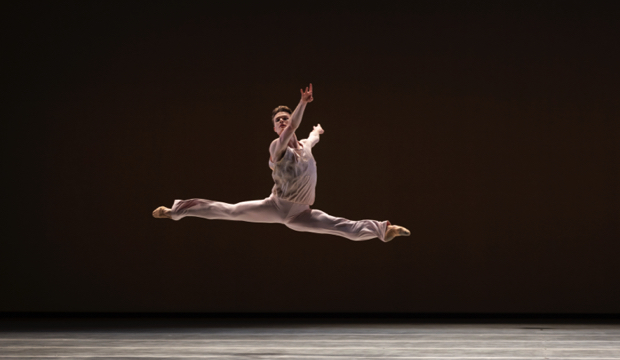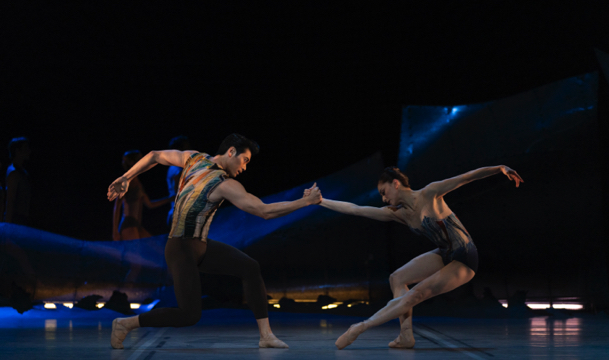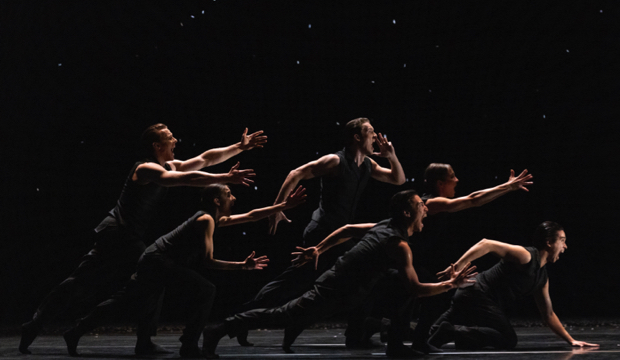The Royal Ballet, The Weathering triple bill review ★★★★★
The American choreographer Kyle Abraham’s new work for The Royal Ballet, The Weathering, had its world premiere as part of a triple bill of contemporary work
Fumi Kaneko in The Weathering, The Royal Ballet © ROH 2022 Photo: Andrej Uspenski
If you were looking for one word to describe Kyle Abraham’s The Weathering it would be ‘gentle’. Another would be ‘delicate’. Abraham's theme is loss, his touch light and elegiac.
Now in his mid-40s, the African-American dancer and choreographer Kyle Abraham is one of the most exciting figures to have emerged on the New York dance scene in the past couple of decades, his work very much grounded in everyday life, his style blending classical technique with contemporary and street moves.
The question was, how would this sit with a predominantly classical company such as The Royal Ballet? Abraham answered it by creating a work of unblemished classical purity, with just the occasional intrusion of a contemporary gesture: a shoulder roll, a sudden crouch.
Softly and atmospherically lit by Dan Scully, with a set of mellow paper lanterns as the only props, the stage becomes a kind of magical box where 11 dancers, two women and nine men, dressed in simple, flowing costumes with the merest hint of pastel (costume designer Karen Young) come together and break apart, their dancing closely following and meshing with Ryan Lott’s score for a small ensemble.

Liam Boswell in The Weathering. The Royal Ballet © ROH 2022. Photo: Andrej Uspenski
In the end, only one dancer is left, framed by the hanging lanterns, which may or may not symbolise the souls of those who left us.
The Weathering slowly wins you over and I suspect will stay with you for a long time to come. It is enormously accomplished, a beautiful, polished work; but it’s not thrilling. It feels as if Abraham has shown The Royal Ballet and its august tradition too much respect. A little more New York vibe, such as permeated his sort of amuse-bouche for the Royal, Optional Family: a Divertissement ,last year, would have been welcome.
Christopher Wheeldon’s 2006 DGV – Danse à Grande Vitesse – made a welcome return to Covent Garden to close the evening.

Ryoichi Hirano and Marianela Núñez in DGV. The Royal Ballet © ROH 2022. Photo: Andrej Uspenski
An energetic, characteristically intricate and fast-moving work for 26 dancers on the theme of travel, it is set to a propulsive score by the minimalist composer, Michael Nyman, Musique à Grande Vitesse, which celebrated the inauguration of the north European line of France's super-fast train service, the TGV (Train à Grande Vitesse).
Jean-Marc Puissant’s set is dominated by a long metal structure, like a deconstructed train, in front of which each of four couples leads one section of the work, with different characteristics: slow, playful, athletic, or seemingly out of time, joined at intervals by the ensemble, who at times sway as if travelling on a train.
It’s all so clever and intense; and the dancers seemed to relish the sheer energy of it.
Sandwiched between the two was Crystal Pite’s Solo Echo.

Artists of The Royal Ballet in Solo Echo. © ROH 2022. Photo: Andrej Uspenski
Inspired by Mark Strand's long poem, Lines for Winter, it is set to sections from Brahms cello sonatas, and performed by seven dancers on a stage so darkly lit it’s practically impenetrable it you are in the upper reaches of the house.
Its theme is apparently angst, leading to the final acceptance of destiny. Crystal Pite has created some powerful, haunting works. Solo Echo, though, is far from her best.
Now in his mid-40s, the African-American dancer and choreographer Kyle Abraham is one of the most exciting figures to have emerged on the New York dance scene in the past couple of decades, his work very much grounded in everyday life, his style blending classical technique with contemporary and street moves.
The question was, how would this sit with a predominantly classical company such as The Royal Ballet? Abraham answered it by creating a work of unblemished classical purity, with just the occasional intrusion of a contemporary gesture: a shoulder roll, a sudden crouch.
Softly and atmospherically lit by Dan Scully, with a set of mellow paper lanterns as the only props, the stage becomes a kind of magical box where 11 dancers, two women and nine men, dressed in simple, flowing costumes with the merest hint of pastel (costume designer Karen Young) come together and break apart, their dancing closely following and meshing with Ryan Lott’s score for a small ensemble.

Liam Boswell in The Weathering. The Royal Ballet © ROH 2022. Photo: Andrej Uspenski
In the end, only one dancer is left, framed by the hanging lanterns, which may or may not symbolise the souls of those who left us.
The Weathering slowly wins you over and I suspect will stay with you for a long time to come. It is enormously accomplished, a beautiful, polished work; but it’s not thrilling. It feels as if Abraham has shown The Royal Ballet and its august tradition too much respect. A little more New York vibe, such as permeated his sort of amuse-bouche for the Royal, Optional Family: a Divertissement ,last year, would have been welcome.
Christopher Wheeldon’s 2006 DGV – Danse à Grande Vitesse – made a welcome return to Covent Garden to close the evening.

Ryoichi Hirano and Marianela Núñez in DGV. The Royal Ballet © ROH 2022. Photo: Andrej Uspenski
An energetic, characteristically intricate and fast-moving work for 26 dancers on the theme of travel, it is set to a propulsive score by the minimalist composer, Michael Nyman, Musique à Grande Vitesse, which celebrated the inauguration of the north European line of France's super-fast train service, the TGV (Train à Grande Vitesse).
Jean-Marc Puissant’s set is dominated by a long metal structure, like a deconstructed train, in front of which each of four couples leads one section of the work, with different characteristics: slow, playful, athletic, or seemingly out of time, joined at intervals by the ensemble, who at times sway as if travelling on a train.
It’s all so clever and intense; and the dancers seemed to relish the sheer energy of it.
Sandwiched between the two was Crystal Pite’s Solo Echo.

Artists of The Royal Ballet in Solo Echo. © ROH 2022. Photo: Andrej Uspenski
Inspired by Mark Strand's long poem, Lines for Winter, it is set to sections from Brahms cello sonatas, and performed by seven dancers on a stage so darkly lit it’s practically impenetrable it you are in the upper reaches of the house.
Its theme is apparently angst, leading to the final acceptance of destiny. Crystal Pite has created some powerful, haunting works. Solo Echo, though, is far from her best.
TRY CULTURE WHISPER
Receive free tickets & insider tips to unlock the best of London — direct to your inbox
| What | The Royal Ballet, The Weathering triple bill review |
| Where | Royal Opera House, Bow Street, Covent Garden, London, WC2E 9DD | MAP |
| Nearest tube | Covent Garden (underground) |
| When |
24 Mar 22 – 07 Apr 22, 19:30 Dur.: 2 hours 40 mins inc two intervals |
| Price | £4-£90 |
| Website | Click here to book |